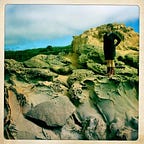A Shimmering Sea in the Mojave Desert
Jamey Stillings’ photographs of Ivanpah Solar Power Facility
From the glittering lights of Las Vegas, one need only drive 45-minutes west to encounter another shimmering man-made temple to human consumption. Instead of sucking power from the grid, however, the Ivanpah Solar Electric Generating System is making power.
For his project The Evolution of Ivanpah Solar, photographer Jamey Stillings spent years hanging out of aircraft, driving through the Mojave Desert for every shoot and criss-crossing throughout the massive solar plant on foot. The effort paid off. Recently published by Steidl, the book The Evolution of Ivanpah Solar is a stunner.
Stillings’ brilliant black-and-white photographs offers a timeline of the facility’s construction combined with essays on various aspects of the project (spoiler: they have a tortoise nursery). The book addresses the controversies surrounding the plant, which shifted from a being a beacon of hope for our collective environmental future, to a harbinger of ecological threat and environmental battles in the region.
This Sunday December 6th, Paris plays host to the World Climate Summit. It is an apt time to look at these photographs again.
Baby Steps
By the time Ivanpah Solar began construction in 2010, Stillings had already been making aerial photographs of the ground from which it would rise.
Stillings photographed from a helicopter throughout construction, catching the plant at every stage. First, there is nothing—just topography and the patterns in the desert sands and rock shaped by wind and water.
Next come the first scratchings into the surface, outlines of what’s to come that produce geometric patterns in the earth. Next come the machines, dozens of them, that excavate and prepare the site for construction. After the concentric circles comes the installation of the heliostat mirrors, which is when things start looking really funky and futuristic.
Stillings shot mostly in the 30-minutes of sunlight at the very beginning and end of the day in order to catch the long rays of sunlight. Once the sun had risen, the scenery quickly became flat and ordinary-looking. Shadows give the photographs dramatic contrast and the series as a whole a commanding weight and depth.
Over the course of four years, Stillings made 19 flights. He started up in the sky because at first he was refused access to the site proper. Knowing the air above was public, Stillings tweaked his plans so as to not abandon the project. Ultimately, his obstruction on the ground and launch into the skies turned out to be extremely fortuitous. Stillings’ aerial images are fundamental — providing consistent wide perspectives and a striking graphic quality that runs through the project
It was only after accumulating enough aerial work and showing it to authorities at charge at the plant that Stillings was granted permission to photograph the site from ground level.
Baby Tortoises
You wouldn’t know it from looking at the photos, but Ivanpah has its own “Head Start” nursery for juvenile desert tortoises.
One year before the plant became operational in December 2013, Jakob Schiller detailed the issues for Wired:
One big problem with renewable energy projects is that they have to go somewhere. They have to occupy a part of the very environment that their proponents are often trying to save.
Problem is, the system is located smack in the middle of the threatened desert tortoise habitat and the companies that built the system have already had to allocate $56 million to care for and relocate these ground dwellers. At least one major environmental group has argued the plant should have never been built on its current location.
In his essay for the book Bruce Barcott details the Mojave’s particular ecosystem, including the tortoises and other critters and plants, as well as the measures taken to offset the existence of the Ivanpah.
One possible pitfall is the attraction of tortoise predators — ravens, kit foxes, coyotes, red- tailed hawks, golden eagles, badgers, and burrowing owls — to the site by trash produced by workers, especially food trash. Once drawn, the predators will happily chomp on a tortoise if and when they spot one.
The presence of, and accommodations for, tortoises destroy rose-tinted and naïve notions that this project didn’t step on anything when it sprang up in the middle of nowhere. Stillings’ the book The Evolution of Ivanpah Solar, therefore combines amazing images with informed analysis by MFA Houston curator emeritus Anne Wilkes Tucker, with enviromental savvy, with the celebrity pizzazz of Robert Redford. This a beautiful photobook charged with vital debate.
Jamey Stillings will be signing The Evolution of Ivanpah Solar at photo-eye Bookstore, in Santa Fe, New Mexico, this Saturday, December 5, from 3–5 pm. To order a signed copy of the book, contact photo-eye.
